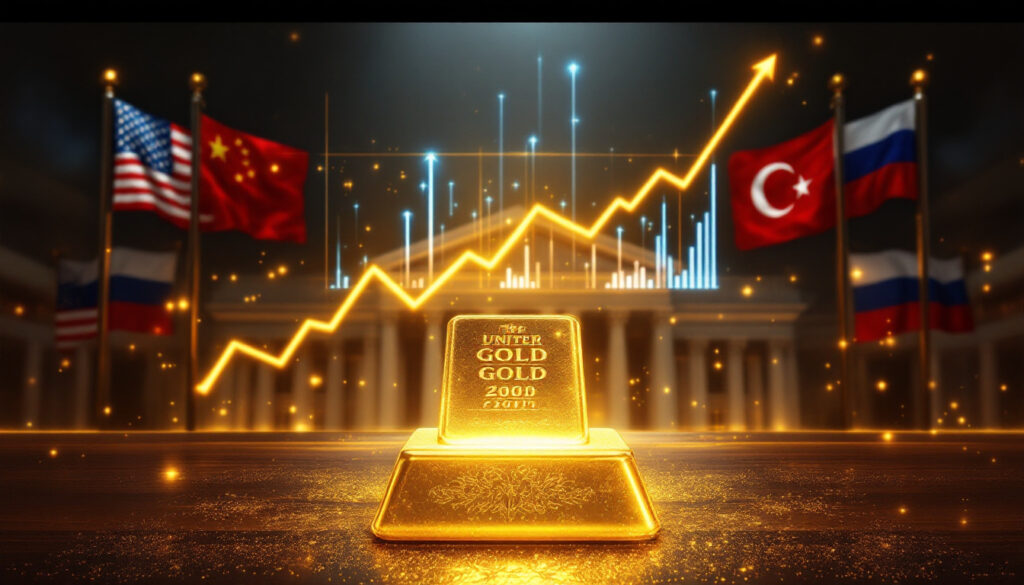The Revaluation of Gold: Understanding the New Monetary Landscape
The global monetary system is undergoing a paradigm shift as gold reemerges as a critical asset for central banks and governments grappling with unsustainable debt levels. Tavi Costa, portfolio manager at Crescat Capital, argues that the revaluation of gold—marking gold to market prices to enhance collateral value—is becoming a strategic tool for managing fiscal instability. With central banks accelerating gold acquisitions and mining equities undervalued relative to broader markets, this report examines the drivers, implications, and opportunities in the evolving monetary landscape.
What Is Gold Revaluation and Why Is It Happening Now?
Gold revaluation refers to the recalibration of gold's value on government balance sheets to address debt imbalances. At current prices, gold's market value has added $800–900 billion to the U.S. Treasury General Account (TGA), enabling potential treasury buybacks to suppress interest rates. Historically, gold-backed debt ratios have plummeted: 40% in the 1940s, 17% in the 1970s, and just 2% today. This 90-year low in U.S. gold reserves relative to global holdings underscores the urgency for revaluation as debt-to-GDP ratios spiral.
The Current Monetary Dilemma
The U.S. faces a structural need to lower interest rates to manage its $36 trillion debt burden, particularly on short-term Treasuries (2-year, 5-year, and 7-year notes). Costa asserts that 2-year yields at 4% are unsustainable and predicts a 50% reduction within 12 months. Revaluing gold could provide the liquidity needed for non-QE interventions, such as directing banks to purchase Treasuries.
Historical Context of Gold Backing
Post–World War II sell-offs and decades of debt expansion have eroded gold's role as a hedge in the monetary system. Emerging markets, meanwhile, have increased reserves to 60-year highs, while the U.S. holds a 90-year low. This divergence highlights a strategic vulnerability as deglobalization incentivizes countries to secure physical assets.
"We live in a fantasy world now. Reality has been destroyed. This is the time you need to pay attention—the probabilities are overwhelmingly on gold's side."
—Tavi Costa
Why Is Gold Rising Despite Technical Signals?
Gold's surge defies traditional technical indicators, driven instead by systemic debt risks and central bank demand. Countries like China, Russia, and Turkey have aggressively accumulated gold to stabilize their monetary systems, with China's reserves rising by 1,448 metric tons since 2000. The U.S. may also be covertly stockpiling gold to bolster the TGA.
Central Bank Buying Pressure
Emerging markets now hold 50-year highs in gold reserves, contrasting with Western underownership. This trend reflects a broader shift toward dedollarization, as nations hedge against currency volatility and U.S. fiscal policies. For those interested in how these trends might develop, the gold market outlook 2025 provides valuable insights into future opportunities.
Debt and Interest Rate Dynamics
With U.S. interest payments consuming 2.4% of GDP—double the OECD average—the Federal Reserve faces pressure to cut rates despite inflation. Costa emphasizes that suppressing short-term yields is critical to avoiding a debt spiral, even if it requires unconventional tools like the revaluation of gold.
How Does Gold Compare to Other Assets in This Environment?
Gold's outperformance relative to equities and commodities signals a reevaluation of risk. Gold miners have delivered superior returns to the S&P 500 over the past decade, yet the sector represents just 0.4% of U.S. GDP—down from 20% in the 1960s. The gold-to-silver ratio, at 110, suggests silver could double or triple if historical mean reversion occurs.
Gold vs. US Equities
Mining free cash flow yields now rival those of the early 2000s bull market, yet valuations remain depressed. This disconnect mirrors the 2001–2011 period, when mining stocks surged 585% amid gold's rally. For newcomers to this sector, a beginner's guide to mining stocks can help navigate these opportunities.
Gold vs. Silver
Silver's underperformance relative to gold reflects its dual role as both monetary and industrial metal. However, renewable energy and AI infrastructure demand could catalyze a rebalance, with silver needing to rise to $60/oz to normalize the ratio.
What Are the Implications for the US Dollar?
The dollar's structural decline is intensifying as interest rate differentials narrow. The U.S. interest payment-to-GDP ratio (2.4%) exceeds Europe's (1.2%) and Japan's (0.6%), pressuring the Fed to prioritize debt servicing over currency strength. A weaker dollar aligns with the administration's goal of reducing trade deficits through tariffs and competitive devaluation.
Structural Dollar Downtrend
The dollar index's overvaluation, comparable to 1985 Plaza Accord levels, suggests a multiyear correction. Emerging markets, particularly in South America, stand to benefit as capital reallocates from overpriced U.S. tech equities to undervalued resources. According to Forbes, this reallocation could fundamentally alter global economic power dynamics.
How Are Mining Companies Positioned in This Environment?
Gold miners offer asymmetric upside with all-in sustaining costs averaging $1,500/oz against gold prices above $2,300/oz. The gold-to-oil ratio, at historical highs, indicates expanding margins, while copper's resilience amid equity selloffs underscores commodity demand.
Mining Company Fundamentals
Exploration-stage firms, though risky, present the highest upside as private equity competes for undervalued assets. Costa highlights that mining's contribution to U.S. GDP must rise from 0.4% to meet onshoring and AI-driven infrastructure needs. Understanding current gold market analysis is crucial for identifying the strongest prospects.
What About the Potential for Market Corrections?
Historically, mining stocks decouple from broader equities during selloffs. In 2008, gold miners gained 35% while the S&P 500 fell 38%. Even a gold pullback to $2,500/oz would leave miners profitable, supporting equity resilience. As reported by Bullion Vault, the revaluation scenario could potentially trigger a substantial uplift in mining equities.
Strategic Positioning
Investors should prioritize miners with low debt and high free cash flow yields. Energy sectors, particularly oil, also offer value, with potential triple-digit prices amid supply constraints. For those looking to diversify, gold ETFs 2024 strategies provide alternatives to direct mining investments.
Conclusion
The revaluation of gold marks a pivotal response to unsustainable debt dynamics, offering governments a lifeline while reshaping global asset allocation. Mining equities, silver, and emerging markets present compelling opportunities as the dollar weakens and rates decline. Policymakers and investors alike must recognize that the "golden age of mining" is not a speculative narrative but a fiscal imperative as monetary systems evolve in response to unprecedented challenges.
Want to Spot the Next Major Mineral Discovery?
Stay ahead of the market with Discovery Alert's proprietary Discovery IQ model, which instantly notifies investors of significant ASX mineral discoveries and transforms complex data into actionable insights. Explore historical returns of major discoveries and position yourself for substantial market gains by visiting our dedicated discoveries page.




